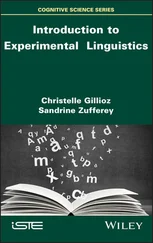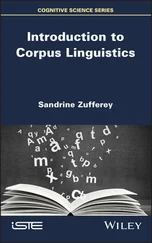314
The Null Subject Parameter
319
Parametric differences between English and German
321
Exercises
325
23 Sentence meanings and Logical Form
330
Preliminaries
330
Thematic roles
333
A philosophical diversion
336
Covert movement and Logical Form
339
Exercises
345
24 Children’s sentences
349
Setting parameters: an example
350
Null subjects in early Child English
351
Non-finite clauses in Child English
354
Children’s nominals
358
Exercises
361
25 Sentence processing
366
Click studies
367
Processing empty categories
368
Strategies of sentence processing
370
Exercises
375
Contents
ix
26 Syntactic disorders
377
Agrammatism
378
Paragrammatism
382
Specific Language Impairment (SLI)
383
Exercises
386
27 Using sentences
388
Context and pronouns
388
Topic/focus
389
Presuppositions
392
Doing things with words
394
The logic of conversation
395
Context and coherence
397
Relevance Theory
398
Taking turns
400
Exercises
402
Further reading and references
405
Conclusion
407
Appendix 1 The International Phonetic Alphabet
411
Appendix 2 Phonological distinctive features
412
Appendix 3 Distinctive feature matrix for English
consonant phonemes
414
Bibliography
415
Index
422
Illustrations
Figures
1 The human cerebral cortex, with the functions of some
areas indicated page 12
2 The human cerebral cortex, with Broca’s Area (BA) and
Wernicke’s Area (WA) indicated
12
3a Centralisation and age on Martha’s Vineyard
19
3b Location and centralisation on Martha’s Vineyard
19
3c Leavers and stayers on Martha’s Vineyard
20
4 Cross-section of the human vocal tract
28
5 Cross-section of the vocal tract, illustrating the articulation
of [m]
30
6 Cross-section of the vocal tract, illustrating the articulation of [n]
30
7 Cross-section of the vocal tract, illustrating the articulation of [ŋ]
31
8 Cross-section of the vocal tract, illustrating the articulation of
interdental sounds
32
9 Cross-section of the vocal tract, illustrating the articulation of
labiodental sounds
32
10 Cross-section of the vocal tract, illustrating the articulation of [j]
32
11 Cross-section of the vocal tract, illustrating the articulation of
palato-alveolar sounds
33
12 The vowel quadrilateral (including only short vowels)
37
13 The vowel quadrilateral (with long vowels)
38
14 The vowel quadrilateral, including mid-closed vowels
38
15 The diphthongs of English
39
16 The vowel quadrilateral, including central vowels
40
17 Sound variation and speaker educational achievement: vowel
assimilation in Tehran Farsi
49
18 The use of standard pronunciations of (ing) and speaker sex
and social class
50
19 Ethnic variation in New Zealand English
50
20 Degree of backing of /ʌ/ among students at a Detroit high school
53
21 A travel agent’s style shifting to clients: (t)-flapping
54
22a Percentage of department store assistants using [r] by store
58
22b Percentage of Saks department store assistants using [r] by age
58
x
List of illustrations
xi
22c Casual and emphatic pronunciations of [r] in New York
department stores
59
23 Stylistic shifts in the speech of a lecturer
60
24 The pronunciation of (o) in Ucieda Spanish by speaker
occupation
60
25 A vowel split in London
65
26 The Northern Cities Chain Shift
67
27 The devoicing of /v/ to [f] in Netherlands and Belgian Dutch
between 1935 and 1993
73
28 An Optimality Theory tableau for the input /pin/ in English
91
29 Preliminary model of child phonology
98
30 Lateral harmony as feature spreading
102
31 Lateral harmony: constructing the output UR
103
32 A dual-lexicon model of child phonology
104
33 Matching input representation to syllable structure template
105
34 Results of an identification experiment for an [ɪ – ɛ]-series
111
35 Results of a discrimination experiment for an [ɪ – ɛ]-series
111
36 Results of an identification experiment for a [b – p]-series
112
37 Results of a discrimination experiment for a [b – p]-series
113
38 A simplified version of the scan-copier model of speech
production
116
39 One view of the structure of the mental lexicon, illustrating
the form of a lexical entry
205
40 A simple concept
206
41 Five conditions in a word/non-word recognition experiment
207
42 Differences between types of speech errors
208
43 Reported use of lexical pairs in New Zealand English
227
44 The adoption of British English by Canadian children
228
45 The lexical attrition of dwile in East Anglia
229
46 Speaker sex and the use of (ing) in casual speech in three
English-speaking cities
234
47a Social class and the use of (ing) in casual speech in Norwich
235
47b Speech style and the use of (ing) among upper working-class
residents of Norwich
235
48 Changes in the use of (ing) in Norwich across the generations
236
49 Ethnicity, levels of interethnic contact and the use of AAVE
morphological features
237
50 Third person singular present tense zero in three locations in
East Anglia
240
Map
The lexical attrition of the word dwile in East Anglia
229
Tables
1 IPA transcription for the English consonants page 29
2 Consonantal sounds arranged by place and manner of
articulation
35
3 The omission of [h] in Bradford
48
4 (th) and (ʌ) in the speech of two Belfast residents
51
5 Deletion of [t] and [d] in English
55
6 A hypothetical implicational scale
56
7 Social, contextual and linguistic variables from Labov’s
study of (r) in New York department stores
57
8 Spirantisation in Liverpool
63
9 Vowel changes in contemporary varieties of English
64
10 [ɑː] and [æ] in Standard British English (RP)
69
11 Vowel changes in an English dialect
72
12 The English phoneme inventory
78
13 A distinctive feature matrix for some common vowels
93
14 Personal pronouns in English
134
15 Examples of derivational morphology in English
144
16 Forms of the Turkish noun EV ‘house’
157
17 Forms of the Latin noun VILLA ‘country house’
157
18 Forms of the Latin noun FELES ‘cat’
158
19 Equivalences between Old and Modern English and other
Germanic languages
231
20 The present tense forms of Modern English help and their
equivalents in Old English and Modern German
234
21 Changes in the Old English suffixes -inde and -inge/-ynge
236
xii
Preface to the second edition
The overall structure of the book is unaltered from the first edition. Our justification for this is set out in the note for course organisers from the first edition that immediately follows this preface. We have, however, made a number of significant modifications.
Читать дальше
![Andrew Radford Linguistics An Introduction [Second Edition] обложка книги](/books/397851/andrew-radford-linguistics-an-introduction-second-cover.webp)











